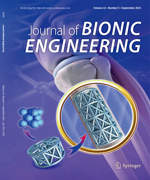Ionic Polymer Metal Composite (IPMC) can be used as an electrically activated actuator, which has been widely used in artificial muscles, bionic robotic actuators, and dynamic sensors since it has the advantages of large deformation, light weight, flexibility, and low driving voltage, etc. To further improve the mechanical properties of IPMC, this paper reports a new method for preparing organic-inorganic hybrid Nafion/SiO2 membranes. Beginning from cast Nafion membranes, IPMCs with various tetraethyl orthosilicate (TEOS) contents were fabricated by electroless plating. The elastic moduli of cast Nafion membranes were measured with nano indenters, the water contents were calculated, and the cross sections of Nafion membranes were observed by scanning electron microscopy. The blocking force, the displacement, and the electric current of IPMCs were then measured on a test apparatus. The results show that the blocking force increases as the TEOS content gradually increases, and that both the displacement and the electric current initially decrease, then increase. When the TEOS content is 1.5%, the IPMC shows the best improved mechanical properties. Finally, the IPMC with the best improved performance was used to successfully actuate the artificial eye and tested.

 Table of Content
Table of Content
 Table of Content
Table of Content